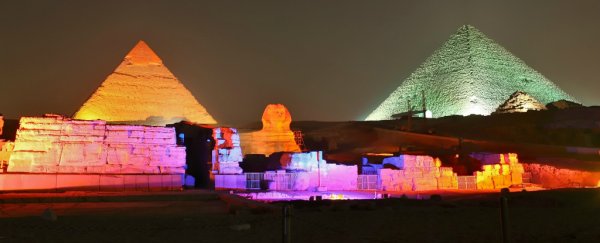There's plenty of talk right now about a certain US politician's thoughts on the purpose of the pyramids. And while we'll let other sites deal with the comments themselves, we wanted to quickly break down the science for you, because despite common belief, the pyramids aren't actually that mysterious anymore.
While there are still some details we don't know, the reality is that there's a whole lot of solid evidence to explain who built them, how they were built, and, yes, even why the pyramids were constructed. So we wanted to go through some of that, if for no other reason than for you to use it during dinner party conversations this weekend (and you know people are going to be talking about it):
First off, the grain idea isn't as ridiculous as it might sound. It's a theory that stems from the Biblical description of text in the Old Testament, and has been around since at least the sixth century, when Saint Gregory of Tours wrote: "They are wide at the base and narrow at the top in order that the wheat might be cast into them through a tiny opening, and these granaries are to be seen to the present day."
You can see why, without looking inside a pyramid, you might think that. But this idea has since been discredited by scientists for a number of reasons.
1. Pyramids aren't hollow: They're incredibly solid and usually only contain a few claustrophobic chambers, connected by long, sloping pathways and concealed entrances, in order to confuse potential tomb raiders. Not a very efficient place to store grain.
2. Ancient Egyptians left instructions inside the pyramids: Archaeologists have found funerary text inscriptions inside pyramid chambers built between 2375 and 2160 BCE, which serve the sole purpose of instructing the dead pharaoh's soul how to cross over to the afterworld. That would be a strange thing to put inside a granary.
3. There's evidence of burial inside the pyramids: "Pyramids were definitely used as tombs: burial equipment, such as sarcophagi, jewellery, mummies or mummy parts were found in some of them. (The others were robbed in antiquity, or in a few cases the burial chambers are below the water table)," archaeologist Deborah Sweeney from Tel Aviv University in Israel told Jewish news site Haaretz over email.
4. There are lots of different pyramids, built over thousands of years: There are more than 100 pyramids known in Egypt, and they were built anywhere between 2686 and 1750 BCE. South of Egypt, in Sudan, there are around 255 of the structures. All the ones studied appear to have served as tombs.
5. Ancient Egyptians actually had granaries: And they've been studied by archaeologists. "These were normally dome-shaped buildings open at the top, which stood near houses and government buildings," said Sweeney.
6. The only grain found in pyramids is part of a burial ritual: To be fair, there have been a few odd remains of grain found in pyramids by archaeologists, but this is part of an Egyptian burial ritual known as the Osiris bed, as the Tour Egypt site explains:
"These are wooden trays in the form of the god, Osiris, which were planted with seeds of grain. They were expected to germinate once the tomb was sealed, and were symbolic of the continuation of life after death."
So there you have it. We think the evidence speaks for itself. And just in case it doesn't, we'll leave you with this:
